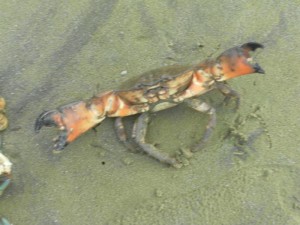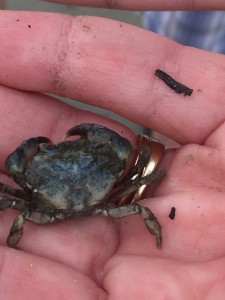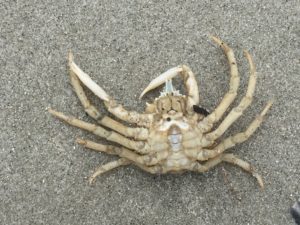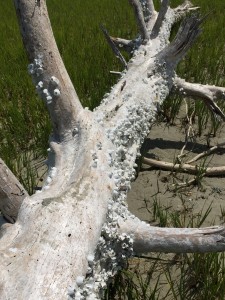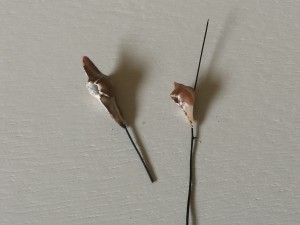Crabs and other crustaceans belong to the phylum Arthropoda, the most widespread and numerous group of animals on the earth. Arthropods are invertebrate (no backbone), have a hard exoskeleton, segmented bodies, and jointed legs. We are quite familiar with what a crab, remembering that a Horseshoe Crab, although an arthropod, is not actually a crab.Crustaceans include the “true crabs,” as well as Hermit Crabs, Mole Crabs, shrimp, and lobsters, and their further classifications is based on sometimes subtle differences in body form and leg placement. Barnacles may look more like mollusks, but are actually sessile (fixed or unmoving) crustaceans.
- The Stone Crab is easily recognized by its dark, heavy shell and large, black tipped claws. The powerful claws can crush human fingers if carelessly handled.
- Juvenile Stone Crab found at a boat launch on Jarvis Creek. The Stone Crab does not swim and are often found on rock jetties, or burrowed into soft sediments.
- Juvenile Stone Crab found at Mitchelville Beach. Young crabs are found in grass and the shell bottoms of channels.
- The shell is oval, without the sharp points that characterize the Blue Crab.
- Stone Crabs prey on barnacles and small oysters and clams, the heavy claws easily cracking the shells of these smaller animals.
- What would you make of this barnacle encrusted creature washed up on the beach? A crab with a tail?!
- This is actually a female Stone Crab whose apron, normally flush against her abdomen, has become detached and extended like a tail.
- A completely detached apron. A more complete discussion about crabs and their aprons can be found on the Blue Crab page.
- The Marsh Squareback Crab. Similar in size and habitat as the Fiddler Crab, the Squareback lives in the upper reaches of the marsh, but also makes forays into areas inhabited by man. Those living near the marsh will often find these endearing little crabs scurrying about the property. The Marsh Crab is one of the few animals that feeds on the marsh grass itself, preferring the older, outer leaves of Spartina Grass.
- Atlantic Mud Crabs. Slightly larger than the Marsh Crab, this crab inhabits the muddy sediments, leaving the upper reaches to the Marsh Crab.
- Speckled Swimming Crab. This white speckled crab is similar in shape to the Blue Crab, but considerably smaller.
- Carapace of a Lady Crab, nearly as long as it is wide. This small crab is known for being aggressive and likely to pinch.
- The Spider Crab has a globular carapace, slightly pointed at one end.
- Beached adult shrimp. Shrimp are scavengers and eat everything, including their own molted shell, the calcium help their new shell harden.
- Juvenile found on a trap in a marsh channel. Newly hatched shrimp are zooplankton, but they return from the ocean to protected waters to feed and grow.
- Barnacles filling an oyster shell.
- Acorn Barnacles resemble little volcanos. A mere three square feet may contain thousands of barnacles, often crowded on top of older barnacles.
- Starting life as zooplankton, after several molts the juvenile barnacle lands and glues itself to a hard surface before changing to its adult form. A six part cone shaped shell is excreted over the soft body, while six pairs of larval legs become cirri, a fan-like structure that waves in the currents, pulling plankton to consume. Like other crustaceans, barnacles grow by molting. However, they do not cast off their shell. The covering of the soft inner body is replaced and the outer shell enlarges to accommodate it.
- Sea Whip Barnacles, not surprisingly, live on Sea Whips.
- Living barnacles are covered with a sheath of sea ship polyps embedded in tissue.
- The small brown barnacles are almond shaped.

